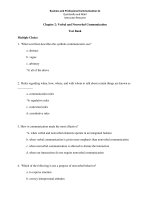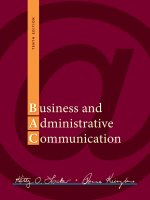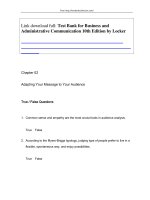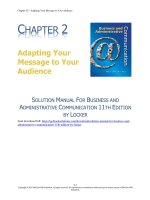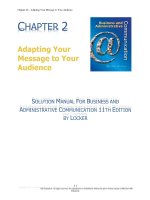Lecture Business and administrative communication: Chapter 12 - Kitty O. Locker, Donna S. Kienzler
Bạn đang xem bản rút gọn của tài liệu. Xem và tải ngay bản đầy đủ của tài liệu tại đây (532.31 KB, 22 trang )
Chapter 12
Building Résumés
Copyright © 2015 McGrawHill Education. All rights reserved. No reproduction or distribution without the prior written consent of McGrawHill Education.
Job Hunting
122
Personal Branding
Marketing yourself
Use a variety of tools:
LinkedIn
Personal web page
Blogs
Facebook
Twitter
Professional forums
Cover letter
Social Networking Cautions
•Remove any unprofessional
material
•Remove negative comments
about current or past
employers and teachers
•Remove political or social
rants
•Remove any personal
information that might
embarrass you
•Remove inappropriate
material posted by friends,
family, relatives
•Check blog for writing aptitude
123
Guidelines: Length
Fill at least one page
Average résumé these days:
2 pages
Put most important information
on page 1
Put at least 10 lines on page 2
Include Name and Page 2
124
Guidelines: Emphasis
Emphasize your achievements
That are most relevant to position applied for
That show superiority to other applicants
That are recent
To emphasize information:
Put it at top or bottom of page
Set it off with white space
Give it in a vertical and/or bulleted list
Include it in an informative heading
125
Guidelines: Details
Give evidence to support your claims
Convince reader
Separate you from other applicants
Use numbers and descriptions
Omit details that add no value
126
Guidelines: Writing Style
Be concise (brief, but complete)
Use phrases and sentence fragments
Never use I; use me or my if you must
Use more action verbs than nouns
List items in parallel form
127
Guidelines: Key Words
Use words or phrases that employers will
have the computer seek
May include:
Software programs
Job titles
Types of degrees
Job-specific skills, buzzwords, jargon
Professional organizations
Honor societies
Personality traits
128
Guidelines: Layout and Design
Experiment with layout, fonts, and spacing to
highlight information
Use no more than three fonts
Use color sparingly
Use at least 10-pt type
Use white space to group items
Consider creating letterhead to use for your
résumé and application letter
Use headings for reading ease
Avoid templates
Select good quality 8 ½ x 11 paper
129
Kinds of Résumés: Chronological
Summarizes what you did in time line
Starts with most recent events, uses
reverse chronology
Includes degrees, job titles, dates
When to use—
Your education, experience closely
related to job for which you’re applying
You have impressive job titles, offices, or
honors
1210
Kinds of Résumés: Skills
Emphasizes skills you’ve used, rather than the
job in which you used them or the date
De-emphasizes job titles, employment history,
dates
When to use—
Your
education and experience not usual route to
applied job
You’re changing fields
You want to show broad experience
1211
Résumé Information: Name and
Contact Info
Use full name, even if you have a
nickname
Center one address; type two side by side
Provide professional e-mail address
Provide phone number
1212
Résumé Information: Education
First main category in these cases—
Earn new degree
Need degree for job you’re seeking
Can present the information briefly
Put it later in these cases—
Need page 1 for another category
Lack degree that other applicants may have
Cover 4-year and graduate degrees
Include junior college if it gave you other expertise
Include study abroad, even non-credit courses
Give degrees, dates, schools, and cities
May list short, descriptive course titles
Include GPA—if it’s good—and what it’s based on: 3.4/4.0
1213
Résumé Information: Experience
Include this information for each job held
Position or job title
Organization
City and state
Dates of employment
Job duties; other details
1214
Résumé Information: Career
Objective
Make it sound like employers’ job
descriptions
Make it brief—2 lines at most
Tell what you want to do, level of
responsibility you want
Targeted to a job at a specific company
1215
Résumé Information: Summary of
Qualifications
Show knowledge of specialized
technology in your field
List accomplishments
Be specific; include numbers and amounts
Include as many keywords as you can
1216
Résumé Information: Honors and
Awards
New college graduates put on page 1
Include Honors and Awards if listing more than three
items
Use Honors and Activities if listing fewer than three
items
Include entries that add to your professional image
Fellowships and scholarships
Awards from professional societies
Major awards from civic groups
Academic honor societies
Varsity letters
1217
Résumé Information: Activities
Critical for new college graduates
Include this kind of information—
Volunteer work and student organizations
Professional associations
Activities involving talent or responsibility
Varsity or intramural athletics
Leadership roles
1218
Résumé Information: References
1219
Résumé Information: What to Omit
Personal information
Controversial activities or associations
High school facts
Trivial items
1220
Electronic Résumés
Basic guidelines of email job hunting etiquette:
Don’t use your current employer’s email
Set up a free, Internet-based email account
Avoid using silly or cryptic email addresses
Write a simple subject line
Test how résumé looks before sending
Send only one résumé
When sending résumé in text of email
Start all lines on left margin
Do not use bold, underlining, tabs, or unusual fonts
Put headings in all caps, but use sparingly
1221
Honesty
ALWAYS BE
HONEST ON
YOUR RÉSUMÉ !!!
1222


